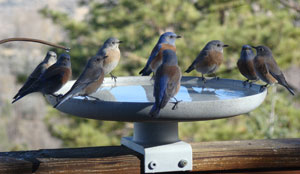
A flock is a large group of birds. During nesting season (spring and summer), bluebirds tend to be seen alone, with their mate, or with their own young. You are more likely to see a flock of bluebirds in the fall or winter. In flocks, migrants may mix with resident birds.
A flock of bluebirds can consist of a half dozen birds to more than a hundred. Some flocks are made up of siblings or all juveniles, some of family units, and some of a mix of juveniles and adults. Different species may flock together during the winter.
There are probably a number of reasons for flocking:
- Territoriality: When bluebirds are nesting, they become more territorial. Hormone levels increase in the spring, which can increase aggression. Limiting the number of competing bluebirds in their home range increases the likelihood that a male or female will get to pass on their own genes (by preventing “extramarital affairs.” (Also, on rare occasions, bluebirds have been known to raid the nests of other birds.) Defending a territory also helps assure that there will be adequate food for their parents and their offspring. When nesting season ends, these factors become less of an issue, and it probably doesn’t make evolutionary “sense” for birds to waste their energy on defense when they can focus on surviving and feeding themselves.
- Siblings: Young bluebirds may hang with each other after fledging for a period of weeks or months. Being grouped together makes it easier for their parents to find and feed them. (Juvenile bluebirds are fed by their parents for about 30 days after fledging.)
- Foraging: In the fall and winter, food can be scarce. Birds can help each other with foraging and locating food supplies like suet feeders or plants with berries.
- Safety in Numbers: The more eyeballs looking out for predators, the more likely that one bird will see and sound an alarm, allowing flock members to escape. Some bird species mob intruders or predators. (I have seen Tree Swallows bombing a Bald Eagle during nesting season.) Having some birds on the lookout means other flock members can focus on eating or conserving energy. Individuals in the center of a flock may be less likely to be attacked. On the flip side, clustering may actually increase the likelihood being noticed by a predator. In mixed flocks, chickadees and titmice often function as sentinels or lookouts, and their alarm calls are recognized by other species in the flock.
- Scoping out Nesting Sites and Mates: In the fall, bluebirds may scope out nesting sites for next year. (Observers who see a flurry of activity around a nestbox in the fall sometimes assume the birds are planning to nest again. which is not the case.) Adults could show young birds potential nesting spots. Being in a flock also increases an individual’s chance of finding a mate when breeding season starts.
- Roosting: Sharing heat in a huddle can help bluebirds survive severe cold weather by reducing heat loss. Usually bluebirds roost in a nestbox or cavity by themselves. However, monitors have found 2-20 bluebirds communally roosting in one box. (BNA) The birds usually fan out their heads so they can all breathe. (Some monitors have found multiple dead birds in a box, but cannot tell whether they suffocated, or died of another cause like cold or lack of food.) More on roosting….
- Migration: Traveling in a flock can be more energy efficient from an aerodynamic standpoint. It also provides safety in numbers for a perilous journey. Migrating bluebirds may join resident flocks. Local birds can help visitors find food, water and places to roost. Bluebirds do not migrate at night. In some areas (e.g., warmer climates), bluebirds do not migrate.
Chickadees form flocks over a period of several weeks in the fall. Flocks may consist of two to 18 birds, and pair bonds are still evident. Chickadees and titmice may also join up in mixed species flocks with other species like nuthatches and woodpeckers. There have been some interesting studies of hierarchies (rank and pecking orders) within flocks.
Related Information and References:
- See high quality, interesting video of bluebirds hanging around a nestbox, hacking up hackberry seeds, iwishicouldfly.com
- Roosting/Roost Boxes
- Bluebird battles
- Predator and Problem Identification and Solutions
- Bluebird Weather: Bluebirds in Autumn
- The Sibley Guide to Bird Life & Behavior
- Black-Capped Chickadee, Wild Bird Guide
- Eastern Bluebird, Wild Bird Guide
- The Birder’s Handbook
– Neltje Blanchan, Birds Worth Knowing, 1917
